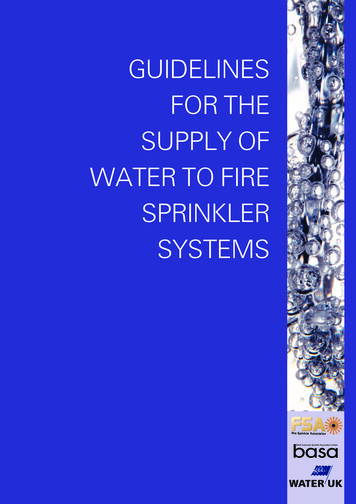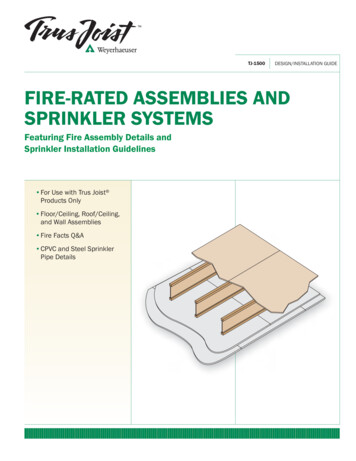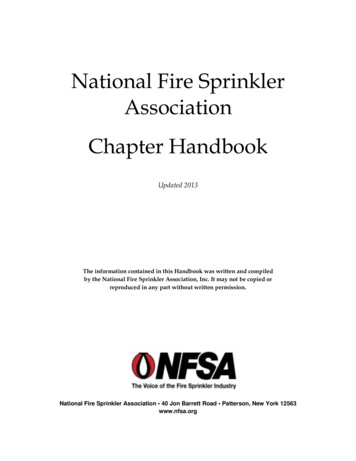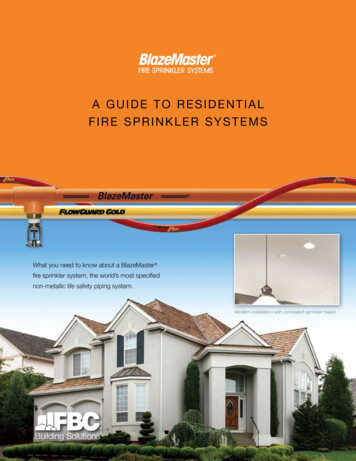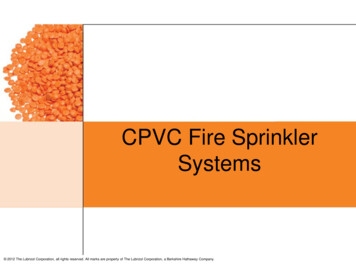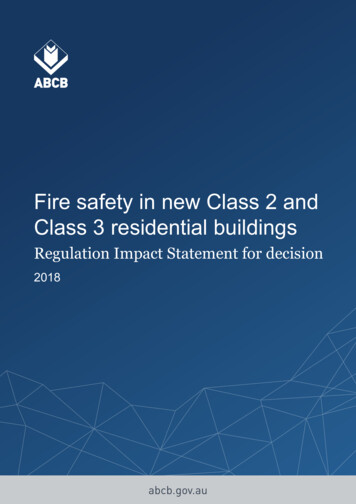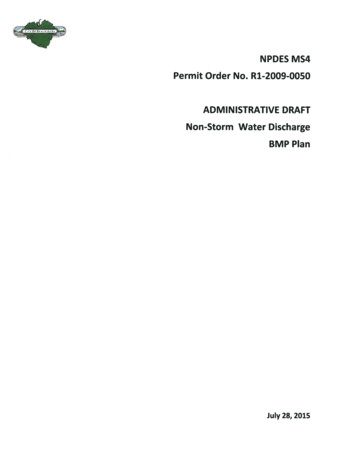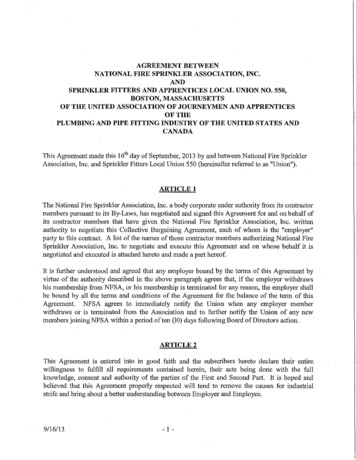
Transcription
-98-736ANALYSIS OF FIRE SPRINKLER SYSTEMSPERFORMANCE IN THE NORTHRIDGEEARTHQUAKERussell P. FlemingNational Fire Sprinkler Association, Inc.4 Robin Hill Park, PO Box 1000Patterson, NY 12563NlsrUnited States Department of CommerceTechnology AdministrationNational Institute of Standards and TechnologyREPRODUCED BY:NIlS.u.s. Department of Co merce '- National Technical Information ServiceSpringfield, Virginia 22161
NIST -GCR-98-736ANALYSIS OF FIRE SPRINKLER SYSTEMPERFORMANCE IN THE NORTHRIDGEEARTHQUAKEPrepared forU.S. Department of CommerceBuilding and Fire Research LaboratoryNational Institute of Standards and TechnologyGaithersburg, MD 20899ByRussell FlemingNational Fire Sprinkler Association, Inc.4 Robin Hill Park, PO Box 1000Patterson, NY 12563January 1998
NoticeThis report was prepared for the Building and Fire Research Laboratoryof the National Institute of Standards and Technology under grant number60NANB5D0132. The statement and conclusions contained in this reportare those of the authors and do not necessarily reflect the views of theNational Institute of Standards and Technology or the Building and FireResearch Laboratory.PROTECTED UNDER INTERNATIONAL COPYRIGHTALL RIGHTS RESERVED.NATIONAL TECHNICAL INFORMATION SERVICEU.S. DEPARTMENT OF COMMERCEReproduced frombest available copy.11
Analysis ofFire Sprinkler System Performancein the Northridge EarthquakeReport Prepared By:Russell P. Fleming, P.E.National Fire Sprinkler Association, Inc.4 Robin Hill Park, PO Box 1000Patterson, NY 12563With Support From:National Institute of Standards and TechnologyGrants OfficeBuilding 301 Room B129Gaithersburg, Maryland 20899-0001
December, 1996Executive SummaryThe perfonnance of nonstructural building components in the January 17, 1994Northridge earthquake has received a considerable attention, especially buildingmechanical systems. There has been much anecdotal infonnation indicating less thansatisfactory system integrity during and following the Northridge earthquake, whichmeasured 6.8 on the Richter scale. Fire sprinkler systems are of special interest since theyare expected to remain functional following earthquakes so as to address post-earthquakefIre hazards, and because of the potential for signifIcant water damage that can take placeif the system is compromised in a building which otherwise remains structurally intact.This project was recommended to include two parts:1. An analysis of the perfonnance offue sprinkler systems in the Northridgeearthquake in relation to the specifIc earthquake protection measures employed intheir design and construction, and2. Development of proposed changes to the national installation standard, NFPA13, which would improve future system perfonnance by bringing brace fastenerdetails and other aspects of the protection rules up to current levels of technology.To aid in the analysis, the two parts have been merged, with the subject matter dividedinto the following twenty subject areas:1. Applicability of Earthquake Protection Provisions2. General Intent of Earthquake Protection Provisions3. Flexible Couplings - General Applicability4. Flexible Couplings for Risers5. Drops to Hose Lines and Sprinklers in Racks6. Flexible Couplings for Expansion Joints7. Seismic Separation Assemblies8. Clearances9. Sway Bracing - General10. Sway Bracing - Loads11. Sway Bracing - Longitudinal Bracing12. Sway Bracing - Lateral Bracing13. Sway Bracing for Excessive Flexibility14. Short Hanger Exception to Bracing15. Bracing / Restraint of Branch lines16. Ceiling / Sprinkler Interaction17. Sway Bracing - Brace Components18. U-Hooks as Sway Braces19. Sway Bracing - Fasteners to Structure2
20. Hanger and Piping Restrictions in Earthquake AreasFor each subject area, a discussion is first presented with regard to the past progression ofrequirements of the NFPA 13 standard. Observations of system performance in theNorthridge earthquake for that subject area are then discussed, including information onthe nature of protection measures employed where applicable. Changes adopted in the1996 edition of the standard (possibly as a consequence of observations from theearthquake) are presented in for each subject area, and fmally additional suggestions forproposed changes to NFPA 13 that might be considered. These proposed changes aregathered from a variety of reports on the Northridge earthquake, from this analysis of theinformation, and from the recent activities of other groups active in the area of earthquakeprotection on nonstructural systems.Work on this project was begun approximately two weeks after the earthquake, with aseries of on-site inspections conducted by staff engineers from the National Fire SprinklerAssociation working in cooperation with the Los Angeles Fire Department, the NationalFire Protection Association, and the Fire Sprinkler Advisory Board of SouthernCalifornia. In the months following the earthquake, a review was made of the damagesurvey forms collected through the Fire Sprinkler Advisory Board of Southern California(FSABSC). Additional forms that were not included in the FSABSC report were alsoincluded. Subsequent review was also made ofNorthridge-based studies andrecommendations from the following groups:California Office of Statewide Health Planning & Development (Ayres & EzerAssociates)California State Fire Marshal's OfficeEarthquake Engineering Research InstituteFactory Mutual Research CorporationNIBS/BSSC Technical Subcommittee on Architectural and Mechanical SystemsFEMAlNEHRP Seismic Rehabilitation Guidelines Project - Nonstructural TeamUnderwriters LaboratoriesInformation and analysis resulting from some of these sources was used as the basis ofproposed changes which were incorporated into the 1996 edition ofNFPA 13 - Standardfor the Installation ofSprinkler Systems. However, the deadlines inherent in processingthe 1996 edition of the standard precluded a full evaluation of the lessons leamed fromthe earthquake.It is not the intent of this analysis to decide appropriate earthquake protection features ofsprinkler systems - those are determined through the consensus standards-developmentprocess of the National Fire Protection Association. However, it is the intent to ensurethat the NFPA Committee on Automatic Sprinklers is aware of all subject areas that needto be addressed in subsequent changes to the earthquake protection requirements ofNFPA 13.3
IntroductionEarthquake protection provisions for fIre sprinkler systems were fIrst included in U.S.national installation rules in 1947, in what was then known as NBFU 13, "Standards ofthe National Board of Fire Underwriters for the Installation of Sprinkler Equipments asRecommended by the National Fire Protection Association." Appendix section A471was entitled "Protection of Piping Against Damage Due to Earthquakes" and consistedonly of the following few paragraphs:"A471 Protection of Piping Against Damage Due to Earthquakes. In locationswhere sprinkler systems would be subject to earthquake shocks, sprinkler pipingshould be installed in a manner to avoid damage from earthquakes. The followingparagraphs indicate general recommendations. The inspection department havingjurisdiction should be consulted for further details."(a) One to two inches clearance should be provided around pipes where they passthrough floors, including floors on the ground, and walls. Clearance holes aroundrisers should be protected with metal collars which will act a fIre stops and waterstops if needed, but will not hold the pipe rigidly. A split ceiling plate or metalcollar should be provided on the underside of the floor also, and space betweenupper and lower collars fIlled with rock wool or other suitable material. Holesthrough fire walls or fire partitions should be covered with split plates or metalcollars on each side of the wall and space between filled with rock wool or othersuitable material."(b) Approved flexible couplings should be installed at one or more points insprinkler system risers as recommended by the inspection department havingjurisdiction."(c) Feed mains and cross mains should be provided with some form oflateral andlongitudinal bracing. U hooks will usually satisfy the requirements for lateralbracing but additional hangers will be required for longitudinal bracing. Hangersto provide longitudinal bracing must be stronger and more carefully installed thanthose for lateral bracing. Where a system is installed with single rods, it will benecessary to provide earthquake bracing in both directions by installation ofspecial hangers. Branch lines do not require bracing. Hangers should be designedto resist motion producing either tension or compression. Attachments should besuch as to develop the full strength of the hanger."The 1950 edition of the document was published as NFPA 13 rather than NBFU 13, butthe earthquake protection recommendations were unchanged.4
The 1951 edition saw major changes, with criteria placed in of the text of the standard forplacement of longitudinal and lateral braces, maximum slenderness ratio of bracemembers, and flexible couplings on risers. The intent was stated to laterally brace thepiping to withstand a force of 50% of the weight of the piping, valve attachments andwater. Figures were added for bracing locations and types of braces, along with a tableindicating maximum lengths of angles, rods, flats and pipe to limit the slenderness ratioto 200. One longitudinal brace was required for each main, and lateral braces were to belocated at intervals of 30 to 40 feet. This criteria remained basically the same for the nexttwenty years.It has been noted (Ayres & Ezer) there were no major earthquakes in large populationcenters in the United States between 1939 and 1971, so the provisions of the NFPAdocument were not really tested until the Sylmar earthquake of February 9, 1991, locatedin the San Fernando Valley of California and measuring 6.6 on the Richter scale.In the 1973 edition ofNFPA 13, the standard was reorganized with the intent to separatethe mandatory and advisory aspects of the document. All advisory material was moved tothe appendix. Since earthquake protection provisions were not intended to be applicableto all systems, the criteria was moved to the appendix and retitled "Protection of PipingAgainst Damage Where Subject to Earthquakes". A new introductory paragraph wasadded to address the overall philosophy:"Protection of damage due to earthquake should be provided in some areas. Thehistory, the intensity and the frequency of earthquakes should be considered indetermining the need for protection of piping against earthquake damage. Theauthority having jurisdiction should be consulted relative to definite areasrequiring protection."In the 1980 edition, with no change of title, key aspects ofthe provisions were movedinto the body of the standard to clarify that they were intended to be mandatory for areassubject to earthquakes. In the six editions of the standard from 1983 to 1994, there wereadditional refmements and improvements in the document. To some extent, these changeswere due to increased attention to earthquake protection resulting from a series ofearthquakes in the western states in the late 1970's and through the 1980's:August 13, 1978October 15, 1979May 2,1983April 24, 1984October 1, 1987Santa BarbaraImperial ValleyCoalingaMorgan HillWhittier5.7 on Richter scale6.76.76.26.1Following the Lorna Prieta earthquake on October 17, 1989, the National Fire ProtectionAssociation, National Fire Sprinkler Association and Society of Fire Protection Engineerssponsored a hearing to gather information on the performance of fire sprinkler systems inthat earthquake. Subsequent changes to the 1991 edition of the standard addressed the5
need to restrain branch lines where movement could damage sprinklers through impactagainst other building features.In preparing the 1996 edition ofNFPA 13, the Committee on Automatic Sprinklers dealtwith 53 proposals to make modifications to its earthquake protection provisions, and 19comments with regard to preliminary Committee action on those proposals. Many of theproposals were the result of observations of system performance in the Northridgeearthquake. However, as has been noted in the Commentary to the proposed NEHRPGuidelines for the Seismic Rehabilitation ofBuildings, very few buildings involved in theNorthridge earthquake had sprinkler piping installed in accordance with the 1991 editionofNFPA 13, the edition that was current at that time. Of the estimated 1 to 2 percent ofthe buildings that failed in the area affected by the Northridge earthquake, two-thirdswere built before 1976 (BOCA, 1994). But just as it is difficult to determine by whatamount newer buildings are safer against earthquakes, so it is impossible to accuratelyassess the total effectiveness of newer NFPA 13 earthquake protection criteria. TheCommittee can only review case histories to determine what are the weak points insystem protection, and try to judge if those weak points have been successfully addressedby successive changes to the sprinkler installation standard.It is not the intent of this analysis to decide appropriate earthquake protection features ofsprinkler systems - those are determined through the consensus standards-developmentprocess ofthe National Fire Protection Association. However, it is the intent to ensurethat the NFPA Committee on Automatic Sprinklers is aware of all subject areas that needto be addressed in subsequent changes to the earthquake protection requirements ofNFPA 13.6
Review ofRelevant Studies and Recent ActivitiesSince the Northridge earthquake, there has been a substantial amount of activity in thearea of protecting nonstructural systems against earthquakes. Part of this activity relatesto follow-up and damage assessment. Other activity is related to national programsworking toward improved earthquake protection for new buildings and for existingbuildings. A summary of some of those activities and programs is as follows.Fire Sprinkler Advisory Board of Southern California (FSABSC)The Fire Sprinkler Advisory Board, an industry-funded organization serving the greaterLos Angeles area, distributed 2,000 survey forms following the Northridge earthquake toelicit information on the performance of fire sprinkler systems. Of this amount, theyreceived 225 completed responses. Most ofthe forms were completed by fitters who didthe actual repairs to damaged systems, although some were filled out by staffbased onfield inspections or telephone conversations with fire protection contractors and others.The Board noted that the City of Los Angeles Department of Water and Power hasidentified about 14,000 fire sprinkler system services, of which 3,300 are located withinthe San Fernando Valley where the earthquake took place.The report acknowledged that system installation practices, including earthquakeprotection requirements, have changed considerably with successive editions of theinstallation standard. However, the survey form did not ask about the year of systeminstallation, or the age of the building. This limited the amount of analysis which couldbe completed based on the survey results. In many cases, however, it was still possible todraw conclusions based on the nature of the failure in terms of the available informationon the system configuration and hanging and bracing techniques and materials employed.This led to the development of a list of types of system damage with corresponding"cause" factors, reprinted in Table 1.The report also noted that significant damage to the water distribution system resulted inapproximately 3,000 leaks within the San Fernando Valley, dropping the water pressureto zero in some areas. On January 22nd, five days after the earthquake, between 40,000and 60,000 customers were still without public water service, and another 40,000 wereexperiencing intermittent service.Although recognizing that the question of sprinkler system damage relative to othermechanical systems would be the subject of debate, the report noted that "in most casesdocumented in this Report, the owners and/or owners' representatives stated almostwithout exception that their automatic fire sprinkler systems performed as well or betterthan the other mechanical systems."7
Table 1FSABSC Northridge Earthquake Survey SummaryDAMAGECAUSE Approximately 2,200 feet of Schedule40 Steel Pipe (up to 8" in size) fell downoff the ceiling of a warehouse. Branch lines fell Underground ductile piping (6-inch)brokenUpright sprigs moved downwards2-inch pipe threads pulled out of coupling Powder-driven studs broke out of concrete U-bolts pulled offBroken hangers/broken pipe Sway bracing pulled outFasteners on 4-way pulled out of wall Overturning rack storage pulleddown overhead piping Replaced recessed fire sprinklers Repaired riser mechanical couplingReplaced hangers8C-clamps (no retainer straps)Powder-driven studs (sway bracing)Seismic bracing- Longitudinal bracing3/8 coach screw rods pulled out ofstructural membersPiping breaks at threadsBackfill not clean (concrete rubble)Joints leakingPiping materialDepth of threads cut into pipePowder-driven studsQuality controlC-clampsSeismic bracing- Lateral bracing- Longitudinal bracingC-clampsMechanical fittingsLag boltsSeismic bracing- Longitudinal bracingExpansion shieldsSeismic bracing- Longitudinal bracingStability of rack storage unitsIn-rack fire sprinklersPiping arrangementSolid ceilings (stucco/sheetrock)sheared sprinklersRidge piping systems did not movewith ceilings6-inch and 8-inch couplingsTolerance (depth of groove)Seismic bracing
Hangers failed Sprinklers pulled up through ceiling Piping material broke at threadsBroken armoversGrooved coupling leakingBroking piping Broken pipe hangersBroken underground pipingBroken overhead piping Sprig up sprinklers rolledBroken overhead piping Broken fire sprinklers 9- Lateral bracing- Longitudinal bracingFasteners used on hangersSpacing and types of hangersSeismic bracing- Lateral bracing- Longitudinal bracingCoach screw rods pulled out of dry"old" woodLags pulled out of wood- Lags hammered in, notscrewed into pilot holeSeismic bracing attached to metaldeckingFasteners pulled outHangers damaged/brokenThreadable thinwall piping materialsTolerance (depth of cut threadsRigidity of materialMovement of large ducts (HVAC)Fastened to ductRubber gasket bridle (old and hard)Seismic bracing- Lateral bracing- Longitudinal bracingSeismic bracing- Fasteners (powder-driven studs)- Clearance through floors andwallsPowder-driven studsPost Indicator Valve (PIV) movedSeismic bracing- Longitudinal bracingFasteners pulled out-Powde drivenstudsMaintaining alignmentC-clamps without retaining strapsSeismic bracing- Lateral bracing- Longitudinal bracingClearance to objects- Installed 'l4" to " from woodbeam
Ayers & Ezer AssociatesThe Ayers & Ezer Associates Report entitled "Northridge Earthquake Hospital WaterDamage Study" was prepared for the California Office of Statewide Health Planning &Development, and involved subconsultants Hillman Biddison & Loevenguth StructuralEngineers. Published in April 1996, the work was started in August 1995 and was basedon hospital damage survey forms and available publications regarding nonstructuraldamage. The report included a review of failmes in pressurized piping systems, includingfire sprinkler, HVAC, and domestic water systems. The report reviewed water damagereports from 13 hospitals in the vicinity ofthe Northridge earthquake. Three of thehospital facilities were shut down in the aftermath of the Northridge earthquake: St.John's in Santa Monica, The Veteran's Administration Medical Center in Sepulveda, andthe Psychiatric Hospital in the Los Angeles County / USC Medical Center Complex. Twoother hospitals, Olive View and Holy Cross, were closed for a week after the earthquakebecause of nonstructural damage.A summary of damage attributed to sprinkler systems in the report is as follows:Tarzana Medical Center (0.3 g) - No damageCedars-Sinai Medical Center (0.4 g) - Sprinklers on I-inch lines crossing aseismic separation on floors 4 through 8 were activated by striking other buildingcomponents. The 90-degree offsets used on each side of the seismic separation didnot allow sufficient flexibility. A below-grade 8-inch supply main also failed.Holy Cross Medical Center (0.4 g) - Short drops (6 to 10 inches long) failed atscrewed tee when sprinklers struck the hard (rated) ceiling within 20 ft ofaseismic separation. Other sprinklers were opened by impact against the ceiling. Areported 1220 sprinklers and 401 two-piece escutcheons were used in thereplacement.Kaiser Panorama City Medical Center (0.45 g) - Main building not sprinklered. Afew failmes of screwed joints and sprinklers in newer wings.Los Angles County USC Medical Center (0.3 g) - Not sprinkleredOlive View Hospital (0.9 g) - Heavy damage reported, especially on top (6th)floor. T-bar ceiling with 5/8 gypsum and flush sprinklers resulted in failmes ofscrewed fittings at tops of drops. A main failed on the 2nd floor. In some places,concealed sprinklers damaged by impact against ceilings.Medical Center ofNorth Hollywood (0.45 g) - No damage10
Northridge Hospital Medical Center (0.5 g) - Three underground pipe failuresonlySanta Monica Hospital Medical Center (0.6 g) - A I-inch line failed at a tee byimpact against a duct.Granada Hills Community Hospital (0.8 g) - No significant damage except forsome C-clamp failuresKaiser Foundation Hospital Woodland Hills (0.35 g) - A "few" sprinklers reportedopenedMotion Picture & Television Hospital (0.4 g) - One or two slow leaks at screwedfittingsSt. Francis Medical Center (0.2 g) - No damageIn the discussion of damage, the report states the following:"The fire sprinkler system sustained less damage than other piping systems in thebuildings. Typical failures were broken C-type clamps, sheared or loosened lagbolts, fractured cast iron fittings, and a few pipe failures. In some buildings,sprinkler heads were damaged or activated when they pounded against adjacentobjects and ceiling elements. The outstanding performance offire sprinklersystems can be attributed to the installation requirements detailed in NFPAStandard 13."One ofthe tasks addressed in the methodology was to evaluate the 1994 edition ofNFPA13 as a potential standard for corrective work.Specific conclusions from the report dealing with fire sprinkler systems were thefollowing:"1. Components failed when differential movements occurred at hard ceilings andwalls, where heads struck other building components, and where lines crossedseismic separations."2. Penetrations through rated corridor or non-rated hard ceilings with inadequatespace for movement around the branch pipe, caused significant damage tothreaded pipe joints."3. Bracing failures (specifically one-sided C-clamps used for gravity hangers)contributed to the pipe movement and failures at screwed joints."11
Many of the general recommendations in the report relate to items already addressedwithin NFPA 13, such as avoiding crossing of seismic separations and avoidingattachment to two structural systems that can move independently. Otherrecommendations are addressed within the particular subject area.Earthquake Engineering Research InstituteSupplement C to Volume 11 of Earthquake Spectra, the journal of the EarthquakeEngineering Research Institute (EERI), contained a Northridge EarthquakeReconnaissance Report which focused on damage from the earthquake, includingobservations on fire sprinkler system performance gathered from EERI investigators.Most of these observations report damage, but without specific information on the natureof the failure. Among the observations and recommendations in that report are thefollowing:-The latest version of the industry and code standard, NFPA 13, is too recent(1991) to have affected many buildings.-The least common but most disruptive and dangerous type of failure was fallingof pipes, including a 12-inch pipe that fell at the Fallbrook Mall in West Hills,demolishing a kiosk.-Incompatible motions of sprinkler piping and other ceiling or ceiling plenumcomponents was a common cause of damage.-There is a possibility that the motions in some buildings were more severe thaneven well-designed, properly installed systems could withstand without someleakage.-Suggestions for preventing leakage in essential facilities include zoning systemsinto smaller areas to allow damaged zones to be shut off, using automatically orremotely controlled shut-off valves, and more rigorous training of designatedpersonnel in shut-off techniques.-The desire to shut off systems following an earthquake to avoid water damagemust be balanced against the need to have systems operational immediately afteran earthquake when there is a higher chance of ignitions as well as lessavailability of fire department resources.-The scientifically preferable way to decide what types of ceilings, sprinklersystems, or storage racks perform best or worst is to collect and analyzecomprehensively collected data on a large and representative sample, rather thanlimited observations combined with judgment.12
-The EERl nonstructural damage report form was little used and data collectedwere insufficient to support statistically valid statements.California State Fire Marshal's OfficeThe Office ofthe State Fire Marshal in California commissioned a report on sprinklersystem performance in the Northridge earthquake. The report led to a number ofamendments to the 1994 edition ofNFPA 13 as it was adopted for official use in thestate:Section 4-6.4.3.5.13 (C-type clamps) Delete "or other approved means to preventmovement." Add a second sentence:"The retaining strap shall be listed for use with a C-type clamp, or shall be a steelstrap of not less than 16 gauge thickness and not less than 1 inch wide for pipediameters 8 inches or less and 14 gauge thickness for pipe diameters greater than8 inches. The retaining strap shall wrap around the beam flange not less than 1inch. A lock nut on a C-type clamp shall not be used as a method of restraint. Alip on a "c" or "z" purlin shall not be used as a method of restraint."Section 4-6.4.3.5.3 (Sway brace components) Add a sentence after the fIrst sentence:"Where pipe is used for sway bracing, it shall have a wall thickness of not lessthan Schedule 40."Also, delete the portion of Table 4-6.4.3.5.3 related to Schedule 10 pipe.Section 4-6.4.3.5.15 (Brace fasteners) Revise as follows:"Lag screws or powder-driven fasteners shall not be used to attach braces to thebuilding structure."(Exception to be deleted)Also, delete the portion of Table 4-6.4.3.5.4 related to lag screws.Table 4-6.4.3.5.4 (Through bolts) Add a note to the table as follows:"A flat washer shall be provided at each end of the through bolt. The diameter ofthe hole shall be not greater than 1/16 inch greater than the diameter of the bolt."A-4-6.4.3.5.1 (Appendix forms) Add new appendix section:13
"The following fonns are provided to assist in the layout, plan review,installation, and inspection of seismic braces. This fonn is not required to be usedfor every brace. A worst case brace calculation is considered acceptable."All of these items were reviewed by the NFPA Committee on Automatic Sprinklers andmost incorporated in the changes to the 1996 edition ofNFPA 13.Factory MutualAs an organization representing several large insurance companies, Factory MutualResearch Corporation publishes its own earthquake protection standards for fire sprinklersystems. Based on its review of the perfonnance of sprinkler systems in the Northridgeearthquake, the Factory Mutual System released a new edition of Data Sheet 2-8,Earthquake Protectionfor Water-Based Fire Protection Systems, dated August 1996. Thenew data sheet represents a substantial increase in severity of earthquake protectionmeasures beyond those detailed in NFPA 13. In fact, many of the changes in the datasheet were proposals that Factory Mutual had unsuccessfully made to change the 1996edition of the NFPA sprinkler standard. The most significant departures from NFPA 13are the following:1. Sway bracing is recommended to consist of either two opposing diagonalbraces or one diagonal brace and one vertical brace. If opposing diagonal bracesare used, each can be designed for one-half the nonnal brace load. If a verticalbrace is used, it can be a hanger if it is located within 6 in. of the point ofattachment of the brace and meets the following additional requirements:(a) The hanger must be able to resist the vertical resultant force VF ,determined aswhere a. is the angle between the vertical hanger and the brace, and H isthe horizontal design load.(b) The slenderness ratio of the hanger does not exceed 200, which can beachieved by means of a rod stiffener.(c) The hanger is attached to the structure through a positive means ofmechanical attachment, such as through bolts, lag screws or concreteanchors which are properly sized for the load.14
(d) The hanger attachment to the fire protection system is snug andconcentric, with no more than I/2-inch between the top of the piping andthe hanger so that excessive movement cannot occur.NFPA 13 requires the resultant vertical force to be addressed where horizontalforce factors are high, but does not specify the arrangement.2. Omission of lateral sway bracing for piping supported by hanger rods less than6 in. long is not be acceptable as it is in NFPA 13.3. The maximum slenderness ratio lIr is limited to 200 to minimize bucklingconcerns. NFPA 13 permits a maximum of 300 with correspondingly reducedloads.4. The maximum distance of lateral and longitudinal braces from the ends of themains being braced is limited to 6 ft and 40 ft respectively. NFPA 13 requiresonly that the last length of pipe be pr
Fire SprinklerAdvisory Board ofSouthern California (FSABSC) The Fire Sprinkler Advisory Board, anindustry-fundedorganization serving the greater Los Angeles area, distributed 2,000 survey forms following theNorthridge earthquake to elicit information onthe performance offire sprinkler systems. Ofthis amount, they received 225 completed responses.
